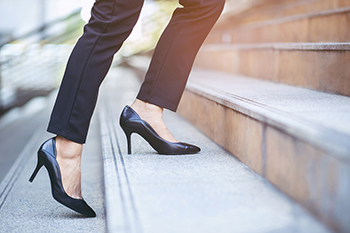
The foot contains three arches that work together to help you move. The system of arches is formed around the tarsal and metatarsal bones and is supported by ligaments and tendons. Two longitudinal arches run from the bottom of the toes on either side of the foot (medial and lateral) and meet at the heel. They are connected by the transverse arch, which runs across the metatarsals (long bones in the foot) just below the toes to form a triangle. This complex system works to put the spring in your step, by bearing the weight and absorbing the shock whenever you stand, walk, run, or jump. The two most common arch conditions are high arches (pes cavus) and flat feet (pes planus). A high arch is caused by an unusually high medial longitudinal arch, which runs along the inner side of the foot. Because it is too high, it is less able to absorb the shock of movement, which then puts stress on the ball and heel of the foot. This can result in pain that radiates to the ankle, leg, and thigh. Wearing custom orthotics and losing weight, can help reduce painful symptoms. Fallen arches, or flat feet, are caused by a lack of longitudinal arches. They may not have developed properly in the first place. Wearing shoes with arch supports usually handles the problem. For more treatment information about painful arch problems, it is suggested that you visit a podiatrist to discuss options.
If you have any concerns about your feet, contact one of our podiatrists from Lewis Wolstein, DPM, P.C. & Associates. Our doctors can provide the care you need to keep you pain-free and on your feet.
Biomechanics in Podiatry
Podiatric biomechanics is a particular sector of specialty podiatry with licensed practitioners who are trained to diagnose and treat conditions affecting the foot, ankle and lower leg. Biomechanics deals with the forces that act against the body, causing an interference with the biological structures. It focuses on the movement of the ankle, the foot and the forces that interact with them.
A History of Biomechanics
- Biomechanics dates back to the BC era in Egypt where evidence of professional foot care has been recorded.
- In 1974, biomechanics gained a higher profile from the studies of Merton Root, who claimed that by changing or controlling the forces between the ankle and the foot, corrections or conditions could be implemented to gain strength and coordination in the area.
Modern technological improvements are based on past theories and therapeutic processes that provide a better understanding of podiatric concepts for biomechanics. Computers can provide accurate information about the forces and patterns of the feet and lower legs.
Understanding biomechanics of the feet can help improve and eliminate pain, stopping further stress to the foot.
If you have any questions please feel free to contact our office located in Co-Op City, NY . We offer the newest diagnostic and treatment technologies for all your foot and ankle needs.




